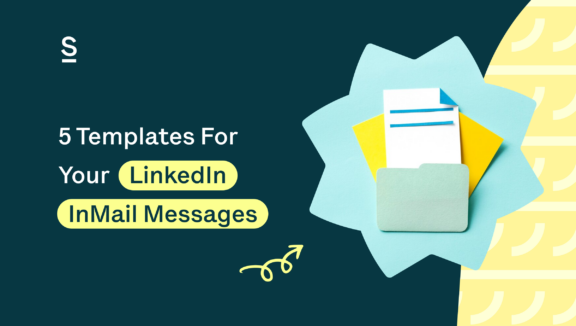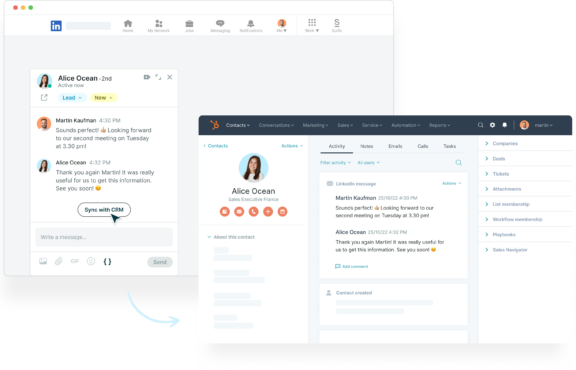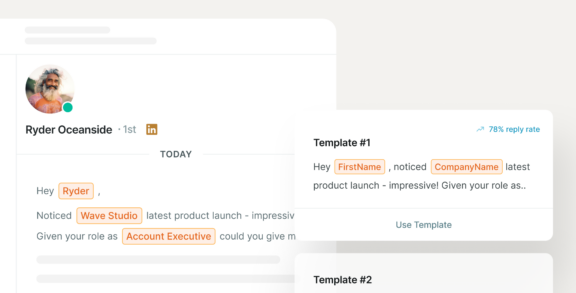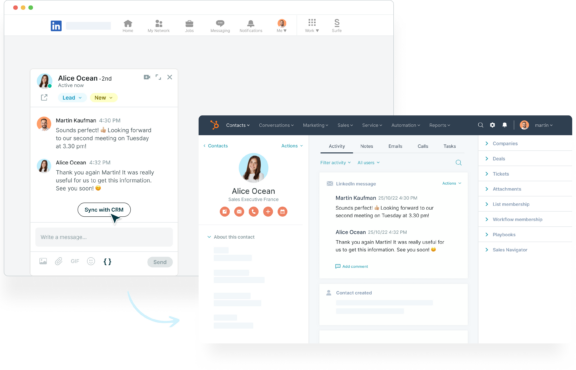5 Templates for Your LinkedIn InMail Messages

Why InMail Matters in B2B Communication
LinkedIn InMail is a must for B2B communication because of it provides salespeople with a direct way to target leads with personalized outreach.
An effective outreach strategy that includes LinkedIn InMail Messages offers:
- Higher open and response rates than cold email
- A direct line of communication with prospects
- The ability to personalize and target outreach
- An opportunity to build and nurture relationships by building credibility and trust
- Tracking of response rates, allowing you to improve over time
- Automatic syncing of LinkedIn InMail Messages to your CRM
Traditional email averages a 1-5% response rate, while the average response rate for InMail can reach up to 25%.
You can take your LinkedIn InMail Message response rate even further by including personalization tactics to send the right message to the right contact at the right time.
By using the Surfe Chrome extension, you can inject personalized templates into messages, send more messages in less time, track the response rate of your outreach, and sync everything with the CRM.
Learn how to use message templates on LinkedIn
Insert message templates in one click, ensure everything is synced with your CRM, and track response rates with the Surfe Chrome extension.
New to using templates? Here are 5 templates that you can use in your outreach:
Template 1: The Connection Request
When you identify a new lead, you can now insert a message template to your connection request. It’s an important opportunity to make a good first impression and set the foundations for your relational-centric sales strategy.
This needs to be personalized – and not just by injecting their name or job title. Browse their profile and look for an interesting post that connects to your sector through a common pain point or lesson.
“Hey #firstname,
I saw your post about [topic]. Just wanted to say thanks for sharing. Really got me thinking about how we handle that on our end at [your company name]. Always a pleasure to connect with #currentposition’s and look forward to learning more about the work you’re doing at #companyname.”
This short and sweet template focuses on the relationship and not the sale. From here, you can start to engage with their content and start a conversation with them that allows you to really discover more about their pain points.

Template 2: The discovery
If you send a message template that opens straight up with a pitch, your response rates will be low. Instead, use insight to open up with a message that touches on a pain point they likely are experiencing based on your research.
It’s important to use statistics here. For example, Surfe provides an email finder tool for LinkedIn. We might open up with something like this:
“Hey #firstname,
I saw your post about [topic] and was wondering whether you’re using any enrichment tools in your day-to-day as a #currentposition? 9/10 #currentpositions are using 2 or more. How many are you using?”
This template opens the door for a conversation by addressing a pain point related to the recipient’s role or industry, but it’s not salesy.

Template 3: The Follow-Up
Following up with the right message at the right time is just as important as your initial outreach.
Studies show that most SDRs give up on a lead if they haven’t replied after 1 or 2 follow-up messages.
However, the data also shows that it can even take 8-10 attempts for an SDR to receive a response from the right contact.
So it’s important to have a variety of follow-ups using different language at different times. Try catching them first thing Monday morning, vary the formality of your messaging, vary the message length and attachments, and finally, using breakup language does still work if they’ve not responded after 8-10 messages.
“Hey #firstname,
I just saw this report about clean CRM data and it reminded me of my last message to you. If it’s useful, let me know. I could run a diagnostic of your CRM and see what % of your data needs updating.”
Template 4: The Feedback Request
Feedback is crucial to building a valuable product, but it’s also necessary for building relationships with your customers.
Taking feedback onboard and genuinely listening to your user base’s opinions can build the foundations of trust and can ensure the user is invested in seeing your product grow.
You can also automate the timing of this to be sent a few days after somebody finishes a free trial.
“Hi #firstname,
Trying to build a tool for #currentpositions is hard. Your genuine feedback about using our trial would be invaluable to me. Would you mind me asking what the main reason for you to not continue using the tool after your trial was?”

Template 5: The Event Invitation
Event invitations can be a good opportunity to create relationships with customers. You’re not directly selling your product or service, but you’re still getting them to commit to building this professional relationship with you. Ticketing for virtual events is also a great way to collect leads, do more discovery, and start warming up those contacts!
You could also mention a referral or common partner/client/company in the same space.
“Hey #firstname,
I just got off a call with the team at [company name] who mentioned you might be interested in [event name]. Were you already thinking of going? Could be a good opportunity for us to grab a coffee together?”
How to increase the response rate of your LinkedIn InMail Messages
Getting more responses to your LinkedIn InMail messages doesn’t happen by magic, but there are some simple steps you can take to ensure your messages are getting a many responses as possible.
- Research and Personalization: We can’t stress it enough. Research your prospects to understand their role, company, and industry challenges or pain points.
Then, use this information to create a connection and offer value, addressing the prospect by name and referencing specific details relevant to their role or industry. Personalized content is 22% more likely to get a response.
- Clear and Compelling Subject Line: Keep it short and to the point. It’s best to craft an attention-grabbing subject line, communicating a value or benefit, in under four words.
- Value-Oriented Content: Speaking of value, focus on how your product or service solves your readers’ challenges. Show the tangible benefit with statistics or use cases.
- Call to Action (CTA): Know when to include a clear and compelling call to action and when to avoid one. When using a CTA to schedule a call or download a resource, the CTA should be specific and actionable.
Remember that sometimes you won’t want to provide a CTA, usually in your initial contact with prospects, as they might make you seem pushy.
- Highlight mutual connections: Mentioning a referral can increase response rates by 500%!
- Track and Analyze Performance: Track the performance of your InMail campaigns. Measure open rates, responses, and conversion rates to identify what works and continually refine your approach. With Surfe, templates users average a 42% response rate.
Surfe’s InMail templates are an effective tool for personalizing outreach and syncing communication to your CRM. When you customize InMail templates, you should see more effective B2B communication and lead generation.
Let’s Wrap It Up!
Well-crafted InMail templates are indispensable for effective sales outreach on LinkedIn. By adapting and customizing these InMail templates over time, you can ensure messages fit the prospects’ unique business needs and communication styles. Using this approach, SDRs and BDRs can elevate their B2B communication and drive more impactful interactions.
Leveraging tools like Surfe can further streamline the process, ensuring that each message is well-crafted and tailored to resonate with the recipient.

Send LinkedIn Message templates with Surfe
Surfe is a Chrome extension designed to make selling on LinkedIn smoother. Add contacts to your CRM in one-click, send message templates, sync messages with the CRM, and more.


